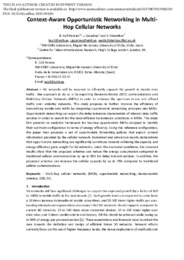Por favor, use este identificador para citar o enlazar este ítem:
https://hdl.handle.net/11000/5102Registro completo de metadatos
| Campo DC | Valor | Lengua/Idioma |
|---|---|---|
| dc.contributor.author | Coll Perales, Baldomero | - |
| dc.contributor.author | Gozalvez, Javier | - |
| dc.contributor.author | Friderikos, Vasilis | - |
| dc.contributor.other | Departamentos de la UMH::Ingeniería de Comunicaciones | es |
| dc.date.accessioned | 2019-04-05T07:35:22Z | - |
| dc.date.available | 2019-04-05T07:35:22Z | - |
| dc.date.created | 2015-09-16 | - |
| dc.date.issued | 2019-04-05 | - |
| dc.identifier.issn | 1570-8705 | - |
| dc.identifier.issn | 1570-8713 | - |
| dc.identifier.uri | http://hdl.handle.net/11000/5102 | - |
| dc.description.abstract | 5G networks will be required to efficiently support the growth in mobile data traffic. One approach to do so is by exploiting Device-to-Device (D2D) communications and Multi-Hop Cellular Networks (MCNs) in order to enhance the spectrum re-use and offload traffic over underlay networks. This study proposes to further improve the efficiency of transmitting mobile data traffic by integrating opportunistic networking principles into MCNs. Opportunistic networking can exploit the delay tolerance characteristic of relevant data traffic services in order to search for the most efficient transmission conditions in MCNs. The study first presents an analytical framework for two-hop opportunistic MCNs designed to identify their optimum configuration in terms of energy efficiency. Using this reference configuration, the paper then proposes a set of opportunistic forwarding policies that exploit context information provided by the cellular network. Numerical and simulation results demonstrate that opportunistic networking can significantly contribute towards achieving the capacity and energy efficiency gains sought for 5G networks. Under the evaluated conditions, the obtained results show that the proposed schemes can reduce the energy consumption compared to traditional cellular communications by up to 98% for delay tolerant services. In addition, the proposed schemes can increase the cellular capacity by up to 79% compared to traditional cellular communications. | en |
| dc.description.sponsorship | The work of B. Coll-Perales and J. Gozalvez has been partly funded by the Spanish Ministerio de Economía y Competitividad and FEDER funds under the projects TEC2014-57146-R, TEC2014-56469-REDT, and TEC2011-26109 | en |
| dc.description.sponsorship | and by the Generalitat Valenciana under research grants ACIF/2010/161 and BEFPI/2012/065 | en |
| dc.description.sponsorship | The work of V. Friderikos has been partly funded by the FP7 ITN CROSSFIRE project | en |
| dc.format | application/pdf | en |
| dc.format.extent | 29 | es |
| dc.language.iso | eng | en |
| dc.rights | info:eu-repo/semantics/openAccess | en |
| dc.subject | Multi-hop cellular networks (MCN) | en |
| dc.subject | opportunistic networking | en |
| dc.subject | device-centric wireless | en |
| dc.subject | D2D | es |
| dc.subject | 5G | es |
| dc.subject.other | 621.3 - Ingeniería eléctrica. Electrotecnia. Telecomunicaciones | es |
| dc.title | Context-Aware Opportunistic Networking in Multi-Hop Cellular Networks | en |
| dc.type | info:eu-repo/semantics/article | en |
| dc.identifier.doi | 1016/j.adhoc.2015.09.004 | - |
| dc.relation.publisherversion | https://doi.org/10.1016/j.adhoc.2015.09.004 | - |

Ver/Abrir:
16-Context-Aware Opportunistic....pdf
1,21 MB
Adobe PDF
Compartir:
 La licencia se describe como: Atribución-NonComercial-NoDerivada 4.0 Internacional.
La licencia se describe como: Atribución-NonComercial-NoDerivada 4.0 Internacional.
.png)